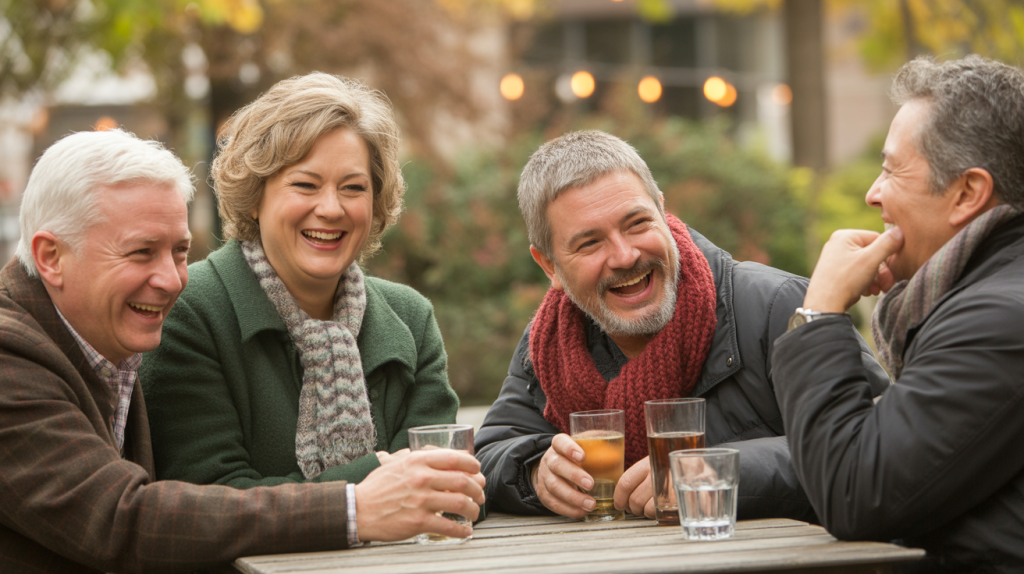I remember the exact moment the feeling settled in, not like a warm blanket but like a heavy, damp coat. I was sitting in my favorite armchair, a cup of tea growing cold on the side table, flipping through a travel magazine someone had left at my book club. Page after page of Tuscan hills, shimmering Greek isles, and the rugged, breathtaking coastline of Oregon.
A deep sigh escaped my lips. It was a sound I was becoming far too familiar with. I had always been a dreamer, a person who lived with a quiet, humming sense of wanderlust. For years, while I was raising my kids and building my career as a librarian, I’d told myself, “Someday.” Someday, I’ll see those places. Someday, I’ll have the time. Someday, I’ll have the money.
Well, “someday” had arrived, at least partially. I was retired, the kids were grown and settled, and I finally had the time. But the money? That was another story. My retirement income was comfortable. It covered my mortgage, my bills, and my small, cherished routines. But it didn’t have a line item for “Italian Villa Adventure” or “Cross-Country National Park Quest.”
Every piece of financial advice I read felt like a slap in the face. “Cut your daily latte!” “Cancel all subscriptions!” “Stop eating out!” The message was clear: to have a joyful future, you must endure a miserable present. I looked around my cozy living room, thinking about the simple things that structured my days with happiness. My morning walk to the corner bakery for a good cup of coffee and a chat with the owner, Maria. My weekly trip to the local bookstore to pick up a new novel. My little garden that brought me peace. My monthly dinner with my two closest friends.
These weren’t extravagant luxuries. They were the threads that wove my life together. The idea of sacrificing them felt like pulling those threads, unraveling the very fabric of my contentment. I felt trapped between a dream that seemed impossible and a present I refused to diminish. I didn’t want to just exist, counting pennies until I could afford a two-week trip. I wanted to live, both now and on those future adventures. I refused to believe it had to be one or the other.
That refusal, that stubborn little spark, was the beginning of everything. I decided then and there, in my armchair with that cold cup of tea, that I wasn’t going to follow the old rules. I was going to write my own. I was going to create a travel fund, and I was going to do it without sacrificing the daily joys that made my life worth living.
The Mindset Shift: From “Cutting” to “Creating”
The first step, and honestly the most important one, wasn’t about money at all. It was about my mindset. The word “budget” felt like a cage, a list of things I couldn’t do. The word “cutting” sounded violent and negative, like I was amputating parts of my life. So, I threw those words out.
I decided to reframe the entire project. I wasn’t cutting my spending; I was redirecting my resources. I wasn’t building a budget; I was designing a “Freedom Plan.” Most importantly, I stopped asking, “What can I give up?” and started asking a much more powerful question: “How can I have what I want in a smarter, more joyful way?”
This simple change in language was transformative. It shifted me from a position of lack to one of creativity and abundance. It felt like I was solving a fun puzzle instead of preparing for punishment. Suddenly, the process seemed less like a chore and more like an adventure in itself. I was no longer a victim of my financial circumstances; I was the architect of my dreams.
My Financial Autopsy: A No-Judgment Look at My Habits
Before I could start redirecting anything, I needed a map. I had to know exactly where my money was going. For one month, I committed to what I called a “financial autopsy.” It sounds a bit morbid, but my goal wasn’t to shame myself. It was simply to gather data with the neutral curiosity of a scientist.
I didn’t use a fancy app. I’m a pen-and-paper person. I bought a simple, slim notebook that I carried everywhere. Every single time I spent money, I wrote it down. The $4.50 for my morning coffee. The $18.99 for a new hardcover book. The $7.25 for a bag of premium potting soil. The $35 for my share of dinner with my friends. Everything.
At the end of the month, I sat down with my notebook, a fresh pot of coffee (brewed at home for this occasion), and a highlighter. I wasn’t looking for “bad” spending. I was looking for patterns. And what I found was fascinating.
I discovered my spending fell into three main categories:
- Core Needs: Mortgage, utilities, groceries, gas. The non-negotiables.
- True Joys: These were the expenses that genuinely, deeply, added happiness to my life. My coffee ritual, my books, my garden, my friends.
- The Fog: This was the revelation. This category was filled with small, almost invisible expenses that didn’t bring me much joy at all. The $12.99 monthly subscription to a streaming service I hadn’t opened in six months. The $5 magazine I bought at the checkout line and never read. The extra $10 I’d spend on pre-cut vegetables out of convenience.
This “Fog” was where my opportunity lay. It wasn’t a huge amount of money, maybe $100 or $150 a month, but it was leaking out of my wallet without providing any real value in return. This was the low-hanging fruit. Canceling that streaming service and one other I’d forgotten about was my first, painless victory. That was $25 a month right there, or $300 a year for my travel fund, and I didn’t feel the loss one bit.
But the real magic happened when I turned my attention to the “True Joys” category. This is where the creative work began.
The Art of Joyful Optimization: Keeping the Joy, Changing the Method
My goal was not to eliminate my joys, but to optimize them. I wanted to find a way to get the same or even greater satisfaction for less money. I tackled them one by one.
My Coffee Ritual, Reimagined
I loved my morning walk to the cafe. I loved the smell, the craft, and the little moment of punctuation it gave my day. Giving it up felt non-negotiable. At $4.50 a day, five days a week, it was costing me around $90 a month. That’s over $1,000 a year – a plane ticket to almost anywhere in the country.
So, I didn’t cut the coffee. I changed its location. I did some research and invested $250 in a high-quality espresso machine and a good grinder. It felt like a huge expense at the time, but I did the math. I started buying delicious, locally roasted beans for about $15 a bag, which lasted me almost a month. My per-cup cost dropped to less than 50 cents.
The initial investment paid for itself in less than three months. After that, I was saving over $80 every single month. I set up an automatic transfer for $80 from my checking account to a new savings account on the first of every month. It was my “Coffee Contribution” to my travel fund.
And you know what? A new joy emerged. I became a pretty good home barista. I learned to froth milk just right. I found a new sense of pride in making a perfect latte for myself. My morning ritual was still intact; in fact, it was now cozier and more personal. I still walked to the bakery once a week to buy a special pastry and say hi to Maria, so I kept the community connection, but my daily habit was transformed.
My Insatiable Reading Habit
As a retired librarian, books are like oxygen to me. I love the feel of them, the smell of them, the promise they hold. My weekly habit of buying a new hardcover book was costing me between $80 and $100 a month. Again, a significant amount.
The obvious answer was the library, and of course, I used it. But I also love owning books, having them on my shelf to revisit. Cutting this out felt like losing a part of my identity.
My optimization here was multi-pronged. First, I fully embraced my local library’s digital and reservation systems. I learned to use the Libby app to get e-books and audiobooks instantly on my tablet. For popular new releases, I put myself on the hold list. The anticipation of the “Your item is ready for pickup” email became its own kind of thrill.
Second, for the books I really wanted to own, I discovered the magic of online used bookstores like ThriftBooks and AbeBooks. I could often find pristine, like-new copies of books for a fraction of the cover price. My rule became: if I want to read it, I get it from the library first. If I absolutely love it and know I’ll read it again, I buy a used copy to keep.
I still allowed myself to buy one brand-new book a month from my local independent bookstore. It was my way of supporting a business I loved while still dramatically reducing my overall spending. This strategy easily saved me $60 a month, which I dutifully transferred to my growing travel fund.
My Social Life and My Garden
A similar thought process went into my other joys. Instead of our monthly dinner out, which could easily cost $50 per person after drinks and a tip, I proposed a new idea to my friends: a rotating potluck club.
The first one was at my house. I made my famous lasagna, one friend brought a beautiful salad and garlic bread, and the other brought a decadent chocolate cake and a bottle of wine. We sat around my dining table for hours, talking and laughing without a waiter hovering or a check to worry about. It was more intimate, more relaxed, and infinitely cheaper. We loved it so much it became our new tradition. We still go out for birthdays, but our regular get-togethers now cost less than $15 each and are filled with more connection than ever.
For my garden, I stopped making impulsive trips to the expensive nursery. I joined a local gardening group on Facebook. I learned about seed swapping, how to propagate my favorite plants from cuttings, and where to get free mulch from the city. My garden became more beautiful and more sustainable, and it connected me with a whole new community of fellow plant lovers.
Unearthing Hidden Treasures: Creating New Income
Optimizing my expenses was creating a steady stream of savings, but I wanted to accelerate my progress. This is where the “creating” part of my new mindset really came into play. I started looking for ways to generate a little extra cash, not by getting a job, but by using what I already had.
The Great Decluttering Gold Rush
My house, like many who have lived in one place for a long time, was a museum of past lives. The attic and basement were filled with things I hadn’t touched in years. My kids’ old bicycles, a set of fine china I inherited and never used, boxes of books I’d already read.
Over a few weekends, I channeled my inner treasure hunter. I put on some music, made a pot of coffee, and got to work. It was surprisingly emotional, holding objects from my past. But it was also incredibly freeing. I took photos and listed items on Facebook Marketplace and eBay.
I was shocked. That set of china I thought was just old? It was a sought-after pattern. I sold it to a collector in Ohio for $400. A vintage lamp I had stored in the attic brought in $75. A collection of old records sold for $120. Over three months, I made nearly $1,500 just by selling things that were collecting dust. It felt like I had found buried treasure in my own home. Every single dollar went straight into my travel fund.
Turning a Passion into Pocket Money
My gardening hobby provided another unexpected opportunity. As I learned to propagate plants, I soon had more than I knew what to do with. I had dozens of little pots of succulents, herbs, and spider plants taking over my sunroom.
A neighbor suggested I take a table at the local weekend farmers market. I was nervous at first, but I decided to try it. I spent a Saturday selling my little plants for $5 to $10 each. I wasn’t trying to build an empire; I just wanted to share my love for gardening and maybe make a few dollars.
That first day, I made $95. But more than the money, I loved the experience. I talked to people, shared gardening tips, and felt a wonderful sense of purpose. I started doing it once a month. Some months I made $80, others I made $150. It was my “hobby income,” and it all went into the travel fund, adding an extra thousand dollars or so each year.
Making it Real: The “Adventure Fund” and Visual Motivation
All of this new money needed a home. I opened a separate, high-yield online savings account. This was crucial. It kept the money out of my regular checking account, so I wasn’t tempted to spend it. I nicknamed the account “My Adventure Fund.” Seeing that name every time I logged into my bank was a powerful, daily reminder of my goal.
I transferred my monthly savings from my “joyful optimizations” automatically. Every time I sold something online or had a successful day at the market, I would immediately transfer the money. Watching the balance grow was incredibly motivating. It was tangible proof that my creative plan was working.
To make it even more real, I bought a large corkboard and hung it in my office. I printed out a picture of my first dream destination: Zion National Park in Utah. I tacked it right in the middle. Every time my Adventure Fund hit a new $500 milestone, I would add a little gold star sticker around the picture. It might sound silly, but that visual tracker made the abstract goal of “saving money” feel like a real, achievable journey.
The Reward: Standing on the Edge of a Dream
Eighteen months after that day in my armchair, I was standing at the Angels Landing viewpoint in Zion, the red and orange canyon sprawling beneath me in the morning sun. The air was crisp, the sky was a piercing blue, and the feeling of awe was so profound it brought tears to my eyes.
I had done it. I had paid for the entire trip—flights, a rental car, a cozy little cabin, park fees, and food—entirely from my Adventure Fund. And I had done it without a single moment of deprivation. I had enjoyed my coffee, my books, and my friends the entire time. In fact, my life had become richer, more creative, and more connected in the process.
As I stood there, I thought about the journey it took to get to that viewpoint. I realized the most valuable things I gained weren’t just the savings, but the lessons:
- Creativity is more powerful than sacrifice. There’s almost always a smarter, more joyful way to achieve a goal than simple brute-force cutting.
- Financial awareness is freedom, not a prison. Knowing where my money was going gave me the power to direct it toward what truly mattered.
- Small, consistent actions compound into massive results. The $80 from my coffee habit, the $60 from my book strategy—they seemed small each month, but together they built a mountain.
- Our daily joys aren’t obstacles. They are the very things that give us the energy and happiness to pursue our bigger dreams. The goal isn’t to eliminate them, but to honor them.
Today, my Adventure Fund is a permanent fixture in my life. The system runs on autopilot. The trip to Zion was just the beginning. I’ve since walked the Freedom Trail in Boston during the fall and spent a week exploring the charming streets of Savannah. On my corkboard, a picture of the Amalfi Coast is now dotted with a growing collection of gold stars.
I created my travel fund not by cutting back, but by leveling up. I became a better barista, a more resourceful reader, a more connected friend, and a more creative gardener. I didn’t sacrifice my daily joys; I enhanced them. And in doing so, I built a bridge from my comfortable present to the adventurous future I had always dreamed of.















